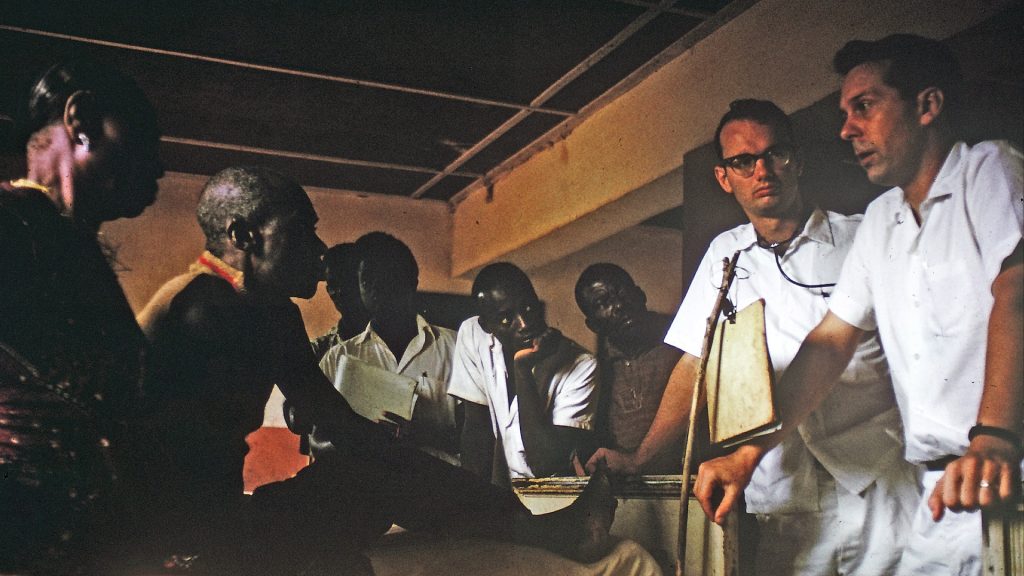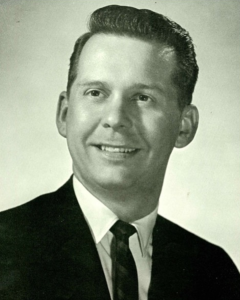Mama Josephine Duale, wife of Rev. Theophile Duale, president of the CEUM, presenting a gift to Lois Carlson, widow of Dr. Paul Carlson; and her son, Wayne Carlson. You can see more photos from the event here >>
Earlier this month the Paul Carlson Partnership (PCP) celebrated its 60th anniversary with an event at North Park University. The evening was filled with stories of the legacy of Paul Carlson, the Covenant medical missionary who was killed on November 24, 1964, while serving in the Democratic Republic of Congo. Participants shared accounts of transformation through PCP’s ministry in partnership with the Congo Covenant Church (CEUM).
Rev. Tammy Swanson-Draheim, president of the Evangelical Covenant Church, spoke about her trip to Congo last year. “I was so impressed being in person with a Congolese hospital run by Congolese staff and a Congolese medical director. It was such a beautiful thing to see because it has always been about partnership, an equal partnership.” CEUM President Rev. Théophile Duale spoke about how he has personally benefited from the medical care available because of PCP’s work to improve infrastructure and train doctors.
Rev. Glenn Palmberg, former president of the Covenant who was instrumental in reviving PCP in 2003, shared remarks on the longlasting impact of the ministry. Father-daughter team and PCP medical ambassadors Dr. Jim Walker and Julie Maylon, RN, spoke on their work training doctors in reducing maternal bleeding after childbirth and training medical staff on safe injection procedures. That training is one way PCP has been able to decrease the maternal mortality rate at the hospital in Karawa by 78 percent between 2012 and 2020. PCP ambassadors and programs have helped to lower infant mortality rates by 50 percent between 2016 and 2020.
Lois Carlson Bridges, widow of Paul Carlson, was also in attendance with several family members. The room was silent and emotional as she shared how meaningful the ministry of PCP is to the memory and legacy of her late husband.
The night highlighted the PCP’s impact on medical care and training, building of bridges and other infrastructure, and economic development opportunities through the Karawa Coffee Project. As Palmberg shared in his comments, “When we care for people’s needs, it communicates a lot about Jesus.”
Immeasurably More: The Mission Inspired by Dr. Paul Carlson’s Bible

Thanks to Becky Dangel, director of partner communications for Paul Carlson Partnership, for compiling this timeline.
At the time of his martyrdom, Dr. Paul Carlson carried his New Testament Bible in his back pocket, a bullet hole piercing its pages. The underlined verses tell a powerful story of faith and courage that sustained his mission in the Democratic Republic of Congo.
This content was originally created as an exhibit for the 60th-anniversary celebration and has been adapted for online publication. Selected passages, highlighted by Paul, help to trace the impact of his ministry to today.
1960–1963
In Colossians 3:23-24, Paul Carlson found inspiration for his mission: “Whatever you are doing, put your whole heart into it, as if you were doing it for the Lord and not for men, knowing that there is a Master who will give you your heritage as a reward for your service.” This Scripture became the foundation for his calling to serve, guiding his decision to respond to the urgent need for medical care in the Democratic Republic of Congo (then Zaire).

1961—Paul volunteered as a physician with the Congo Protestant Relief Association. He felt a profound responsibility to care for those who had little access to medical treatment in the wake of Congo’s independence from Belgium.
1962—The Ubangi Church of Christ invited Paul to return as a full-time medical missionary. With the support of the Evangelical Covenant Church, he committed to a three-year stay, relocating his family—his wife, Lois, and their children.
August 1963—Arriving in Wasolo, Paul became beloved by the locals, who affectionately called him Monganga Paulo, meaning “My Doctor Paul.” With dreams of building a hospital in Loko, Paul dedicated himself to the people of Congo, driven by a belief that he was to be the hands and feet of Christ, serving the underserved with compassion and love.
1964
1964—Congo was in turmoil following Simba rebel insurgents declaring a “People’s Republic” in Stanleyville. Many missionaries evacuated. Dr. Paul Carlson took action to protect his family, relocating his wife and children to the Central African Republic. However, he returned to his post, feeling compelled to care for his patients as long as possible.
Tensions escalated much quicker than he could have anticipated. Captured by the Simba rebels in September, he was brutally tortured and falsely accused of being a spy. During his three-month imprisonment, he constantly heard threats of execution and came to anticipate his death, writing:
For me to live and die is gain—this becomes more real each day. I’ve had beatings and knowing what it means not to know the future for tomorrow. Where I go from here I know not, only that it will be with Him. If by God’s grace I live, which I doubt, it will be to His glory….I can only realize when I see such difficulties as we have seen that we need to work all the harder for our Lord. I’m praying that through this we might see revival in our churches in the Ubangi, in the hearts of all of us, and our Congolese brothers too.
He found strength and comfort in Matthew 10:19-30, underlined in his Bible. Amid uncertainty and fear, these underlined verses helped him remain steadfast, knowing that God was with him, watching over him with deep, personal care.
On November 24, 1964, during a chaotic rescue operation by Belgian paratroopers, the situation reached its tragic climax. As the rebels fired into the crowd of prisoners, Paul and others made a desperate attempt to escape. Before climbing a wall to safety, Paul encouraged a fellow missionary to go first. As he attempted to follow, he was fatally shot. Although he had lived in the Congo just over two years, his body was buried in Karawa among the people he loved.

The then governor of the Ubangi Province in the Congo wrote Paul’s wife, Lois, “I am able to assure you that the sacrifice of your husband will not have been in vain. In fact, the grave where he rests in a village of our province will remain always as a reminder to us that in the midst of the hatred and violence that troubled our Congo, a man willingly gave himself to die for an idea of peace, love, and brotherhood.”
In the weeks following his death, Paul’s story captured the world’s attention. His photograph appeared on the covers of Time and Life magazines, his tragic fate a powerful symbol of martyrdom during the turbulent conflict in Congo.
1965–1974
1965—Lois Carlson published Monganga Paul, a heartfelt account of her husband’s life and work. That same year, despite the turmoil, the Covenant Church in Congo invited missionaries to return.
To honor Paul’s legacy, the Paul Carlson Foundation was established to improve medical services and education in Central Africa. The foundation embodied Paul’s heart for service, reflecting the verses he had underlined in his Bible: “And it is in God’s power to provide you richly with every good gift; Thus you will have ample means in yourselves to meet each and every situation, with enough to spare for every good cause” (2 Corinthians 9:8).
1966—Lois returned to Congo with a team to identify a project that could carry on Paul’s dream of providing sustainable medical care. She visited Wasola and Loko, where Belgians had built a leprosarium that was never occupied. Paul had envisioned Loko as a potential medical center. After meetings with Congo’s president, Mobutu Sese Seko, the government agreed to deed the hospital to the foundation.
1968—The Paul Carlson Medical Center (PCMC) at Loko was dedicated, fulfilling Paul’s dream. The center started with 140 beds and quickly expanded, establishing satellite clinics and programs in nutrition, agronomy, and microenterprise.
1970s—Under the leadership of Arden Almquist, PCMC flourished. The Covenant Church in Congo became its own entity, known as the Communauté Évangélique de l’Ubangi-Mongala (CEUM). By 1973, the Paul Carlson Foundation evolved into the Paul Carlson Medical Program (PCMP).
1975–1984
Between 1975 and 1984, PCMP advanced its mission of holistic community development, focusing on health, agriculture, and spiritual care. Institut Medical Evangélique de Loko (IMELOKO), established in memory of Paul, trained people in sustainable farming, health, and sanitation, empowering them to combat malnutrition and disease. Training of midwives and clean water projects improved community health.
1979—Dr. Sambe Duale became the first Congolese doctor at Karawa Hospital, marking a significant step toward local leadership in healthcare.
1984—The Zulu Falls hydroelectric project brought electricity to Karawa, enhancing medical services. The 1980s also brought challenges. PCMP restructured, expanded programs, and secured new funding. Through these efforts, the team remained committed to serving, embodying the spirit of 2 Corinthians 5:9 underlined in Paul Carlson’s Bible: “We therefore make it our ambition, wherever we are, here or there, to be acceptable to him.”
1985–1994
1991—PCMP merged with Covenant World Mission. In September, riots erupted in Kinshasa and spread. The US embassy ordered an evacuation, forcing 89 Covenant missionaries to leave. The absence of foreign personnel placed a heavy burden on local leaders. Yet the CEUM was resilient, ensuring many departments continued to function under challenging circumstances.
1992—The CEUM invited missionaries to return, marking a renewed commitment to serve, despite instability in the region. The daily pressures faced by the mission team echoed 2 Corinthians 11:28 underlined in Paul Carlson’s Bible: “There is the responsibility that weighs on me every day, my anxious concerns for all our congregations.’’
1995–2004
1995 to 2004—PCMP faced challenges as Congo descended into chaos during the First and Second Congo Wars. Missionaries were forced to evacuate in 1997. The CEUM continued operations amid widespread violence, including the kidnapping and beating of CEUM President Luyada Gbuda. Through it all, the words Paul Carlson underlined in Ephesians 6:12—“For our fight is not against human foes, but against cosmic powers, against the authorities and potentates of this dark world, against the superhuman forces of evil in the heavens”—reflected the spiritual battle the mission faced.
2003—President of the Covenant, Glenn Palmberg, rediscovered the Time Magazine story on Paul, sparking a revival of the organization. The program reemerged as the Paul Carlson Partnership (PCP).
2004—Lois Carlson Bridges and son Wayne returned to Congo to mark the 40th anniversary of Paul Carlson’s death, highlighting the resilience of the mission and impact.
2005–2014
2005 to 2014—PCP focused on supporting the CEUM medical system, which included four hospitals and numerous clinics. Rehabilitation of the Zulu hydroelectric plant helped strengthen healthcare infrastructure.

2008—PCP shifted to strategic initiatives focused on sustainability. The Farmers to Markets (FTM) microfinance project organized more than 1,400 farmers into associations, a hallmark of PCP’s commitment to economic empowerment.
2009—PCP took on key infrastructure projects in partnership with Hope International Development Agency, notably the construction of bridges essential for improving transportation and access to medical care.
2010— PCP formed the PCP Medical Ambassadors, volunteers who raise funds, donate medical equipment, and provide hands-on training in specific skills. Paul underlined verses in Matthew 10:5-8 where Jesus instructs his disciples to “heal the sick” and “you received without cost; give without charge.” The medical ambassadors did exactly that.
2015–2024
2015–2024—PCP made substantial progress in healthcare and economic development. As Paul had underlined in his Bible, “And it is in God’s power to provide you richly with every good gift; thus you will have ample means in yourselves to meet each and every situation, with enough and to spare for every good cause’’ (2 Corinthians 9:8). This verse remained a source of encouragement for PCP as they partnered with local communities to create sustainable, long-term solutions.
2015—The Congo Clinic Initiative launched, enhancing 120 clinics with solar power, refrigeration, clean water, and medical supplies. These improvements greatly increased healthcare access in rural areas while PCP’s Medical Ambassadors trained local healthcare professionals.
2018—The CEUM celebrated 50 years of Loko Hospital.
2021—A major infrastructure project was completed with the construction of ten bridges reconnecting Bogose Nubea and Karawa, restoring an 85-kilometer route that had been impassable for 30 years, and opening access to medical care, education, markets, and churches.
2017 to 2021—The Karawa Coffee Project was completed, reviving coffee production with over 2,000 local farmers. This project continues to alleviate poverty and build economic stability.
November 2023—The CEUM celebrated 100 years of the gospel in the region, baptizing more than 700 people in a celebration with leaders from the Covenant and PCP.
To participate in the ongoing ministry of the Paul Carlson Partnership through prayer or financial support, visit www.paulcarlson.org.














